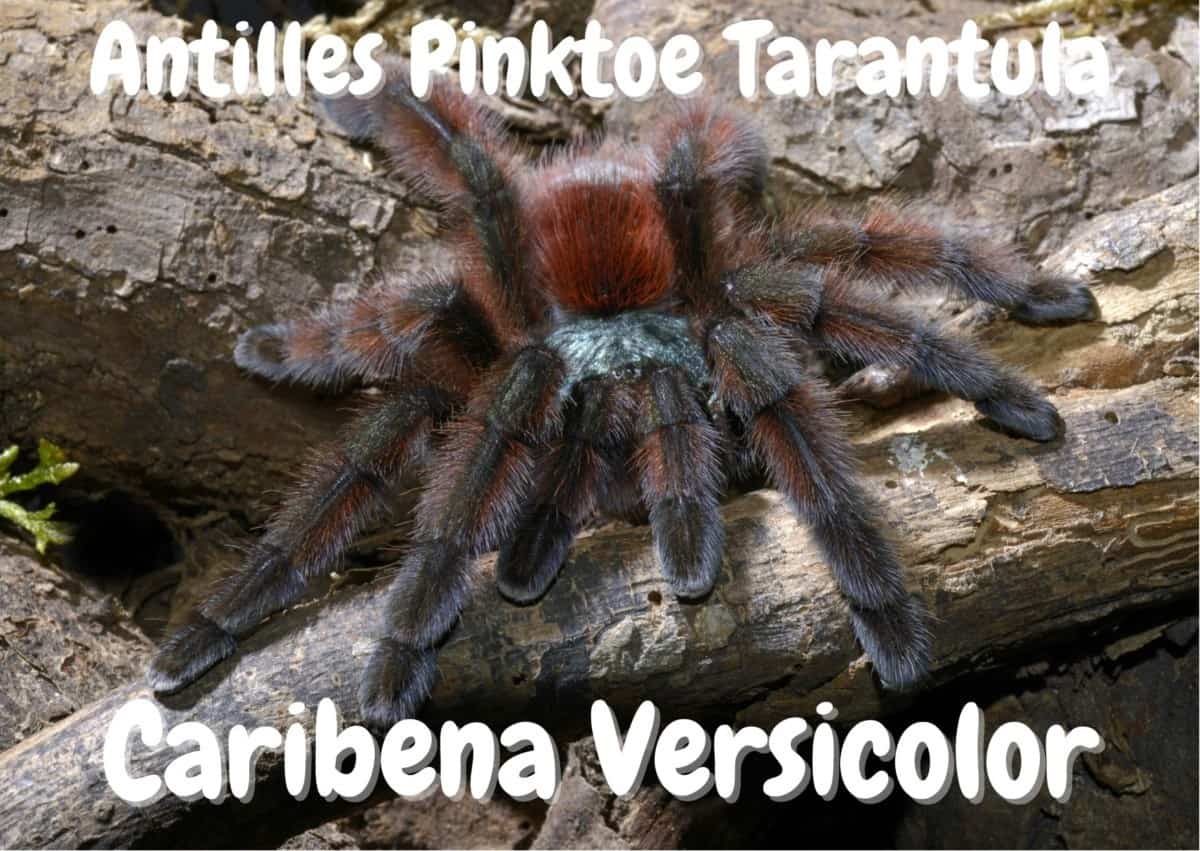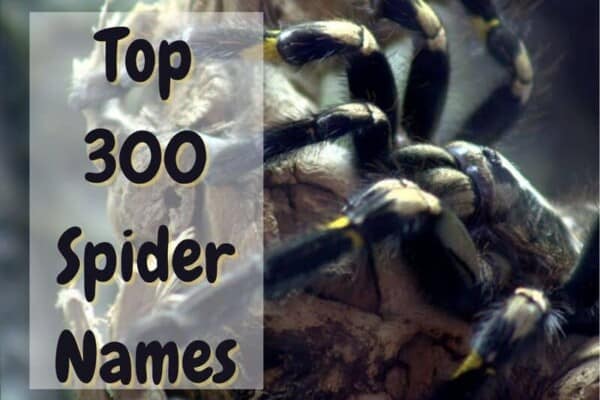For such a strange-sounding name, the Antilles Pinktoe is one of the most dazzling-colored spiders you’ll see. The vibrant shimmering color is another reminder of how the look can be deceiving.
Though they can be testy at times, they are a great addition to an avid collector. This species found its way from the jungles of Martinique in the Caribbean. Are you experienced enough for this wild-at-heart arboreal spider?
Antilles Pinktoe Tarantula Overview
| Scientific Name | Caribena Versicolor |
| Dwelling | Arboreal |
| Size | 5 – 6 inches |
| Lifespan | 2-3 years (male) / 10-12 years (female) |
| Food | flies, crickets, grasshoppers, dubia roaches, mealworms |
| Difficulty | Beginner to intermediate |
Caribena versicolor– First discovered by Charles Athanase Walckenaer (1837) Not to be confused with the Avicularia Versicolor (which is a similar species). This species is also called the Martinique Red Tree Spider.
Characteristics of the Antilles Pinktoe Tarantula
These tree-dwelling spiders are vividly colored and don’t follow the typical pattern for keeping their colors all the same. The Antilles Pinktoe can be colored electric blue to rosy reds and rusty highlights. There are also iridescent greens with purple highlights and abdomens that can include bright red hairs to ornate stripe designs.
There is a bald-looking spot toward the base of the abdomen – it isn’t from rubbing, it simply has a bald-like patch. The carapace has two distinct colors that include bluish-green and iridescent jade green with touches of blue. Just like a box of chocolates, you just never know what you’re getting.
Size
In the first year, a female will grow to 2.5 inches in length (68mm). Adult females can reach 6 inches in length (15+cm). The slings are less than 0.5 inches when they hatch.
Behavior of the Antilles Pinktoe Tarantula
You will need to be on your guard with this species. While it is docile at first glance it can turn on you if you make it spooked. This beauty does have an attitude and should not be pushed to its limit if they don’t want to play nice. They will prefer to avoid confrontation and retreat when cornered.
Temperament
This species will show its attitude in many ways. First, it will like to flick the urticating hairs at you. The second is jumping to a safe place. The third is slinging feces at you, which can be icky, to say the least. Besides being skittish, they are questionable at times due to their mood swings.
Biting effects
The bite is not lethal in any way so you won’t be at risk if they do bite. They aren’t known to be biters but it can happen if you handle them.
Lifespan
Females are not long-lasting but still pretty impressive for such a colorful spider – they can live up to 12 years. Sadly though, the males will have just 3-5 years in all before they die.
Difficulty of Care
This is a beginner to intermediate-level spider. You should be experienced enough to know how to deal with moody spiders that have a lot of spunk too. Approaching them will tell you right away what they don’t want.
Housing the Antilles Pinktoe Tarantula
This tarantula is an arboreal species that will need a tall enclosure with a lot of decor in it. It will also need a special modification to its enclosure that allows crosswind air to go through the tank.
This means that holes need to be added to the tank for this to work. Try finding a special tank that offers this, then that will work best for this spider. If not, then you will need to have special holes drilled into the glass.
A shop that specializes in cutting and drilling glass is recommended for this task. Holes need to be small enough that legs cannot slip through. Plastic would be easier to burn holes with a soldering iron but is just not suitable for this kind of spider.
A 5-gallon tank is best for a mature female. Depending on your tank, a front access hatch is good to drop in food. Have a secure hatch that fits snugly too.
Humidity
This is going to be a moist tank that needs about 80-90% humidity all year long. With the need for cross-ventilation that humidity will go away a lot faster. So spraying is going to be your next best method to rehydrate that climate. It will need to be done every day. Just don’t spray the spider in the process. Keep a hygrometer in the tank to monitor that level very often.
Temperature
The temperature needs to be at a constant 80-82F. Don’t use a heating lamp since this will just cook your spider. Place a heating pad underneath the tank at a low temperature to make one side of the substrate warmer and generate the right kind of temperature needed. It will also help with humidity. Next to your hygrometer, put your temperature gauge. If they are the kind that sticks to the glass, these are perfect.
Lighting
This climbing tree spider likes to avoid light as much as possible. If you do add light it will be for show anyway. Use a 30-watt warm incandescent bulb. Choose a lamp that has a swivel head so you can position it easier above the tank or to the side. Give them no more than 12 hours if you want to let your spider think this is real sunlight.
Substrate
With all the humidity involved, substrates like soil and moss mixtures are going to go through some rough weather ahead. So it must be sterile before it goes into the tank. Cook the soil, moss, or anything organic that goes into the tank. Keep bacteria at a minimum by cooking the substrate in an oven at 150F for 1-2 hours.
Just to be sure let the soil sit for a day so it can be completely dry. Use a nice mix of sphagnum and peat moss mixed with topsoil and vermiculite. Each of them should make up for one-quarter of the volume. The Pink Toe tarantula does not burrow so the level in the tank can be two inches or more.
Cleaning
The substrate will be more moist than usual so the cleaning needs to be done more often. Once a month is fine but be on the lookout for growing mold in the substrate. Since this spider is an avid webber, it might be hard to tell where mold is growing. So it’s best to be on the lookout and check regularly under the surface behind the glass.
Accessories
The Antilles Pinktoe will often like to climb. So you will want to have some sort of tree-like structure they can climb onto. Don’t use a real tree since there could be bacteria or parasites living in it. Anything that simulates wood is fine such as plastic tree limbs that look like the real thing. It will be covered in webbing veils anyway.
Feeding the Antilles Pinktoe Tarantula
You can give them a steady diet of live crickets, grasshoppers, and dubia roaches. Spiderlings will need smaller prey that has been sized down. Little mealworms and headless crickets are good choices.
How often does the Antilles Pinktoe need food?
An adult will eat about 2-3 live crickets per week. They must be alive since this species of spider likes to hunt. This happens at night, so just place these crickets in the habitat when you go to bed. Whatever is left over in the morning is what you should take out.
Drink
Be sure to give the mature spiders water that is stored in a Snapple cap. Change the water every other day. Place water at the same level as the substrate. This will allow the Antilles Pink Toe to drink easier. Little slings don’t need a big cap so anything that can go into an aspirin cap is good for them.
Handling the Antilles Pinktoe
You can easily handle the Antilles Pinktoe but these spiders are very fast, so if you need to move it, you may want to direct them into another cage enclosure with tools. A long-tipped paintbrush or drumsticks are good at keeping yourself from harm. Use these too to gently nudge your spider around. They like to flick hair and poop, so beware.
Common health problems
This spider will become ill if they do not have its habitat at the right temperature and humidity. If you make the substrate sterile they will be less likely to become infected by mites or bacteria as well.
They are hearty spiders that do well if they are given the proper care that they need. When it comes to molting they need to be left alone. If they don’t eat, it’s probably a sign they are going to molt soon anyway.
Breeding the Antilles Pinktoe Tarantula
Females need to be at least two years old and then will molt in the 2nd year to reproduce. Males can start after one year. Pairing can be a dangerous thing so take care when putting them together. They need to be well-fed to prevent the death of your males.
This species is pretty hard to breed in captivity so it can take many years to perfect this. If the male is successful he will be lucky if he survives long enough after the mating to see spiderlings hatch.
How many eggs does the Antilles Pinktoe lay?
It is possible to see up to 100-200 or more eggs that can eventually hatch into slings. This can take 4 weeks to hatch. If you were careful enough to get the egg sack from the mother, you can put the eggs in an incubator set-up and watch the hatch in a matter of time. It depends on how long the female has had her egg sack carried around with her.
What to do with spiderlings
This species is very appealing to spider collectors so any slings you have can be sold off at a nice profit – especially with the hard work that goes into breeding this species. The best time to sell them is when they reach 0.25 inches in length.
Availability and price of the Antilles Pinktoe
Exotic pet stores rarely breed their own Antilles Pinktoe spiders since they are hard to breed at times. If you are looking to buy a Pinktoe sling you can expect to see prices starting at 85-90 dollars for tiny slings that are starting to show abdomen stripes.
Don’t be put off by price since these are always high-priced spiders in general. There are online forums you can visit to find out where spider expo shows are being held. This is where you can buy cheaper slings that are on sale.
Resources and further reading:
- Taxonomic revision and cladistic analysis of Avicularia Lamarck, 1818 (Araneae, Theraphosidae, Aviculariinae) with description of three new aviculariine genera, Caroline Sayuri Fukushima and Rogério Bertani
Contents [show]













